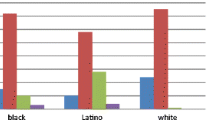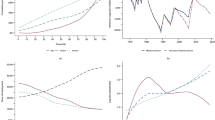Abstract
The effects of firm and job characteristics on the wages of blacks and whites are analyzed using data from the 1988 National Longitudinal Survey of Youth [Bureau of Labor Statistics, 1997]. This study focuses on 2,370 full-time private sector employees. The results show that, first, blacks are disproportionately employed in large establishments despite their lower cognitive achievements. Second, blacks do not enjoy significant wage premiums associated with supervisory positions. Third, although the wage gap between blacks and whites is reduced considerably, controlling for education and cognitive skills, the gap increases significantly when structural attributes are included in the wage regressions despite the large wage premiums associated with employment in large establishments.
Similar content being viewed by others
References
Baron, James N.; Bielby, William T. “Bringing the Firm Back In: Stratification, Segmentation and the Organization of Work,”American Sociological Review, 45, October 1980, pp. 737–65.
Brown, C.; Hamilton, J.; Medoff, J.Employers Large and Small, Cambridge, MA: Harvard University Press, 1990.
Bureau of Labor Statistics.National Labor Survey Handbook, Columbus, OH: Ohio State University, 1997.
Dickens, William T.; Katz, Lawrence. “Interindustry Wage Differences and Industry Characteristics,” in Kevin Lang; Jonathan S. Leonard, eds.,Unemployment and the Structure of Labor Markets, New York, NY: Basil Blackwell, 1987, pp. 48–89.
Evans, David; Leighton, Linda S. “Why Do Smaller Firms Pay Less?,”Journal of Human Resources, 24, 2, October 1988, pp. 299–318.
Freeman, Richard B.; Medoff James L.What Do Unions Do?, New York, NY: Basic Books, 1984.
Granovetter, Mark. “Small is Bountiful: Labor Markets and Establishment Size,”American Sociological Review, 49, 1984, pp. 323–34.
Hodson, Randy. “Companies, Industries and the Measurement of Economic Segmentation,”American Sociological Review, 49, 1984, pp. 335–48.
Foulkes, Fred K.Personnel Policies in Large Nonunion Companies, Englewood Cliffs, NJ: Prentice Hall, 1980.
Kluegel, James R. “The Causes and Costs of Racial Exclusion from Job Authority,”American Sociological Review, 43, June 1978, pp. 285–301.
Krueger, Alan B.; Summers, Lawrence H. “Efficiency Wages and the Inter-Industry Wage Structure,”Econometrica, 56, 1988, pp. 259–93.
Kwoka, John E. “Monopoly, Plant, and Union Effects on Worker Wages,”Industrial and Labor Relations Review, 36, 1983, pp. 251–7.
Lester, Richard. “Pay Differentials by Size of Establishment,”Industrial Relations, 7, 1967, pp. 57–67.
Long, J. E.; Link, A. N. “The Impact of Market Structure on Wages, Fringe Benefits and Turnover,”Industrial and Labor Relations Review, 36, 1983, pp. 239–50.
Marshall, Ray. “The Economics of Racial Discrimination: A Survey,”Journal of Economic Literature, 12, 1974, pp. 849–971.
Masters, Stanley. “An Interindustry Analysis of Wages and Plant Size,”Review of Economics and Statistics, 51, August 1969, pp. 34–45.
Mellow, Wesley. “Employer Size and Wages,”Review of Economics and Statistics, 64, 3, 1982, pp. 495–501.
Neal, Derek; Johnson, William. “The Role of Premarket Factors in Black-White Wage Differences,”Journal of Political Economy, 104, 5, 1996, pp. 869–95.
Oi, Walter. “Heterogeneous Firms and the Organization of Production,”Economic Inquiry, 21, 1983, pp. 147–71.
O'Neill, June. “The Role of Human Capital in Earnings Differences Between Black and White Men,”Journal of Economic Perspectives, 4, 1990, pp. 25–45.
Smith, James P.; Welch, Finis. “Black Economic Progress After Myrdal,”Journal of Economic Literature, 27, June 1989, pp. 519–64.
Stolzenberg, Ross M. “Bringing the Boss Back in: Employer Size, Employee Schooling and Socioeconomic Achievement,”American Sociological Review, 43, December 1978, pp. 813–28.
Villemez, Wayne J.; Bridges, William P. “When Bigger is Better: Differences in the Individual Level Effect of Firm and Establishment Size,”American Sociological Review, 53, April 1988, pp. 237–55.
Author information
Authors and Affiliations
Rights and permissions
About this article
Cite this article
Mitra, A. Structural characteristics of firms and industries and black and white wage inequality in the U.S. economy: 1988. Atlantic Economic Journal 27, 179–192 (1999). https://doi.org/10.1007/BF02300237
Issue Date:
DOI: https://doi.org/10.1007/BF02300237




